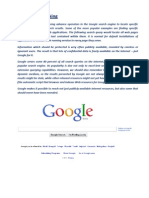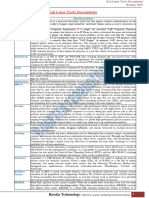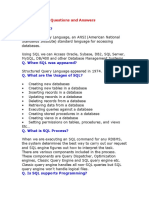0 ratings0% found this document useful (0 votes)
18 viewsSQL Interview Questions by Skill Arbitrage
Uploaded by
sandeep yadav (sakhat londa)Copyright
© © All Rights Reserved
Available Formats
Download as PDF, TXT or read online on Scribd
0 ratings0% found this document useful (0 votes)
18 viewsSQL Interview Questions by Skill Arbitrage
Uploaded by
sandeep yadav (sakhat londa)Copyright
© © All Rights Reserved
Available Formats
Download as PDF, TXT or read online on Scribd
You are on page 1/ 2
SQL Interview Questions and Answers
1. What is SQL and its main features?
SQL is the language used to interact with databases. It helps in retrieving, adding, updating,
and deleting data. Key features include querying data (SELECT), modifying data (INSERT,
UPDATE, DELETE), and managing the database structure (CREATE, ALTER, DROP).
2. Order of writing SQL query?
- SELECT (what data you want)
- FROM (where it’s from)
- WHERE (filter the rows)
- GROUP BY (group similar data)
- HAVING (filter groups)
- ORDER BY (sort the results).
3. Order of execution of SQL query?
SQL runs in this order:
- FROM (choose the table)
- JOIN (combine tables)
- WHERE (apply filters)
- GROUP BY (group results)
- HAVING (filter groups)
- SELECT (choose columns)
- ORDER BY (sort results).
4. Common SQL commands?
- SELECT: Get data.
- INSERT: Add new data.
- UPDATE: Modify data.
- DELETE: Remove data.
- CREATE: Make a new table or database.
- ALTER: Change an existing table.
- DROP: Delete a table or database.
5. Primary key vs. Foreign key?
- Primary Key: Uniquely identifies each row in a table.
- Foreign Key: Links one table to another, referencing the primary key in the other table.
6. Types of joins?
- INNER JOIN: Returns matching data in both tables.
- LEFT JOIN: Returns all data from the left table, even if no match in the right.
- RIGHT JOIN: Returns all data from the right table, even if no match in the left.
- FULL JOIN: Returns all data from both tables, with NULL where there’s no match.
- CROSS JOIN: Combines every row from both tables.
7. Window functions?
- ROW_NUMBER(): Number each row.
- RANK(): Assign ranks with gaps for ties.
- DENSE_RANK(): Similar to rank, but no gaps.
- LEAD()/LAG(): Get data from the next/previous row.
8. What is a stored procedure?
A stored procedure is a reusable set of SQL commands that you can run like a program, great
for repetitive tasks.
9. Difference between stored procedure & functions?
- Stored Procedures: Can return multiple values, modify data, and use output parameters.
- Functions: Always return a single value and can’t change data directly.
10. What is a trigger?
A trigger is an automatic action in the database that runs when you insert, update, or delete
data.
11. WHERE vs HAVING?
- WHERE: Filters rows before grouping.
- HAVING: Filters after grouping, often used with aggregates like COUNT() or SUM().
You might also like
- The Organization of Information 4th Edition (2017, Libraries Unlimited)97% (34)The Organization of Information 4th Edition (2017, Libraries Unlimited)483 pages
- Dangerous Google - Searching For Secrets PDF88% (26)Dangerous Google - Searching For Secrets PDF12 pages
- Voyager 7S Data Dictionary - Through Update DB 5854 - 06061967% (3)Voyager 7S Data Dictionary - Through Update DB 5854 - 0606193,877 pages
- Understanding Database Types - by Alex XuNo ratings yetUnderstanding Database Types - by Alex Xu13 pages
- Policy Document Ucc Redemption Understanding The Process Further80% (20)Policy Document Ucc Redemption Understanding The Process Further37 pages
- Power Pivot and Power BI: The Excel User's Guide to DAX, Power Query, Power BI & Power Pivot in Excel 2010-2016From EverandPower Pivot and Power BI: The Excel User's Guide to DAX, Power Query, Power BI & Power Pivot in Excel 2010-20164/5 (10)
- Dark Web Market Price Index Hacking Tools July 2018 Top10VPN291% (11)Dark Web Market Price Index Hacking Tools July 2018 Top10VPN27 pages
- Color-Coded Genealogy Research Filing SystemNo ratings yetColor-Coded Genealogy Research Filing System15 pages
- Complete SQL Syllabus With Resources & Interview Q&A PlaylistsNo ratings yetComplete SQL Syllabus With Resources & Interview Q&A Playlists6 pages
- Top 100 SQL Interview Questions and Answers (2025)No ratings yetTop 100 SQL Interview Questions and Answers (2025)34 pages
- Top 100 SQL Interview Questions and Answers (2025)No ratings yetTop 100 SQL Interview Questions and Answers (2025)50 pages
- What Is Major Difference Between SQL and PLSQL?No ratings yetWhat Is Major Difference Between SQL and PLSQL?70 pages
- Technical Questions With Answers - Data ManagementNo ratings yetTechnical Questions With Answers - Data Management12 pages
- Index: S.N O. Experiment Date Remark S T. SignNo ratings yetIndex: S.N O. Experiment Date Remark S T. Sign34 pages
- SQL Interview Questions and Answers: Q. What Is SQL?No ratings yetSQL Interview Questions and Answers: Q. What Is SQL?21 pages
- Oracle SQL and PLSQL Interview Questions and AnswersNo ratings yetOracle SQL and PLSQL Interview Questions and Answers21 pages
- SQL SERVER - 2008 - Interview Questions and Answers - : Pinaldave100% (2)SQL SERVER - 2008 - Interview Questions and Answers - : Pinaldave26 pages
- Data Type: - What Is SQL? Write It's Data Type. AnsNo ratings yetData Type: - What Is SQL? Write It's Data Type. Ans34 pages
- Questions (SQL) : Saved To The Database. DCLNo ratings yetQuestions (SQL) : Saved To The Database. DCL15 pages
- What's The Difference Between A Primary Key and A Unique Key?100% (1)What's The Difference Between A Primary Key and A Unique Key?36 pages
- 1) General Questions of SQL SERVER What Is RDBMS?: Read More Here100% (1)1) General Questions of SQL SERVER What Is RDBMS?: Read More Here26 pages
- Krishnaik06 The-Grand-Complete-Data-Science-MaterialsNo ratings yetKrishnaik06 The-Grand-Complete-Data-Science-Materials45 pages
- Open Source Intelligence (Osint) Reference Sheet0% (1)Open Source Intelligence (Osint) Reference Sheet23 pages
- Other Link Classified - How To Find The Book I WantNo ratings yetOther Link Classified - How To Find The Book I Want453 pages































































































